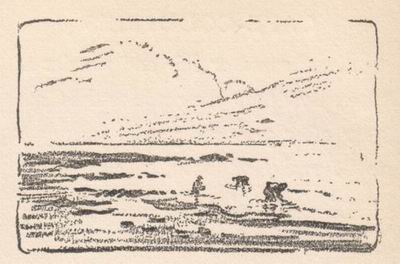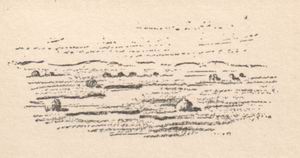| Copyright, Kellscraft Studio 1999-2003 (Return to Web Text-ures) |
Click
Here to return to Cape Coddities Content Page Click here to return to Previous Chapter |
 (HOME) |
| Copyright, Kellscraft Studio 1999-2003 (Return to Web Text-ures) |
Click
Here to return to Cape Coddities Content Page Click here to return to Previous Chapter |
 (HOME) |
 XIII SCALLOPS
SPORT, according to our highest authorities, is "that which diverts and makes mirth," and from this general interpretation the term has been applied to games, and to the various forms of hunting and fishing commonly known, but I have yet to hear the word applied to the pursuit of the scallop. And yet, scalloping more nearly approaches the original meaning of sport than most of the games which are commonly classed under this heading, for not only does the scallop divert and provoke the mirth of his pursuer, but the pursuer in turn evokes a similar feeling and impression upon those who chance to see him in action. Those who have never tasted the joys and excitement of a scallop hunt have not completed their education as real sportsmen. It is true that Badminton does not devote a volume to this particular pastime; it is equally true that the progressive American journalist, whose duty it is to supply the sporting columns of his paper with all the news of current athletic events, invariably ignores this important item, and our mighty Nimrods fail to include scalloping among their feats of prowess; but in each case the cause of the omission invariably can be traced to ignorance, and to the fact that your scallop-hunter is a wary fellow who says but little and boasts less, fearing inadvertently to disclose the favored haunts of his favorite prey. And so, for these and divers causes, the pursuit of the scallop lies in obscurity. On the other hand, the scallop has been a friend to man for generations in many and varied ways. In the days of the Crusaders, the pilgrims returning from the Holy Land wore scallop shells, gathered upon the coast of Palestine, as a badge or mark of the success of their wanderings. At an equally early period the scallop shell became an important factor in design, from architecture, through the various stages, to the adornment of women's clothes. The scallop shell is discovered embedded in the capitals of many famous columns. It will be found chiseled upon the keystones of countless arches. Scarcely a theater but possesses it among its mural decorations. Upon the title-pages of books it serves in an equally decorative capacity, while the scalloping upon the hems of dresses brings the scallop's shell familiarly into our family life. In addition to all this, certain families of ancient lineage have adopted the shell as a part of their crest. Heraldry traces the cause to the days of the Knights of the Holy Land. The scallop, therefore, has been sought by generations, and is no marine upstart basing his claims to popularity upon his flavor as a savory dish for a modern Lucullus. In short, the scallop is historic, artistic, decorative, and delicious. In real life, however, he is one of the numerous marine bi-valve mollusks of the genus Pecten, and to those who have not already recognized the symmetrically ribbed shells so often found upon our beaches, a dictionary is recommended. Although his past is buried in the annals of the Holy Land, in AEgean waters, and upon the banks of the Red- Sea, just at present-he is rampant upon the shoals of Cape Cod, and it is here that our scallopers pursue him during the weeks previous to early autumn days, when the Cape fisherman wages destruction with sea-rakes, seines, and nets. Imagine the tide running low, disclosing the bright, sandy bottoms of countless inlets, the ripple of the waters making dim the outlines of the corrugated surfaces of the submerged shore. At such times, and in certain localities which shall be nameless, the wily hunter issues forth in bathing-suit or rubber-booted, or even -- in the enthusiasm of the moment -- fully clothed, with pail or basket sometimes attached to his waist by a cord. He wades in at a slow pace, gazing searchingly into the depths of the water for a sign of his prey, choosing at first the shoals where it is easier to see, and as likely a spot as others for fine shellfish. And here a curious phenomenon is discovered; his eye catches the glint of a shining shell and he stoops to secure it, only to find a half shell without life. The brighter the shell, the less chance of its being inhabited. The scallop covers himself when possible with a few strands of seaweed, or buries himself in the mud or sand, and therefore, when in the full bloom of life, he looks like a hoary, hairy thing of past history, an encrusted shell from which life might have departed a century ago. If, by good fortune, the hand comes in contact with him, however, his vitality is made quickly evident by a savage snap of his shell, as the large muscle expands and contracts in self-defense, and should a finger become caught between the upper and lower shells, the hunter is in for a sharp nip. The quest leads from spot to spot, from shoal water out into deeper parts, until one finds one's self waist-deep, bending and stooping, raking the bottom with frenzied hand groping for these tufted prizes, and when one is fortunate to secure a good spot, the hand never fails to bring up one, two, and sometimes more, of these irate creatures whose antics evoke admiration and whose strength seems almost abnormal. There are bright, warm days in the latter part of August when on many parts of the shore may be seen men, women, and children by scores, curiously and wonderfully garbed, grotesquely postured, wading the waters in this fascinating pursuit, which, after the quiet glamor of clam-digging, possesses the excitement of big-game hunting. Were it not for a strict law these same hardy hunters would, undoubtedly, be found in dories, plying a small net for the same purpose, but the very crudity of the chase has its advantages, for one comes close to the life of the sea bottom, and all that goes on there, from the waving masses of seaweed of many varieties to the countless forms of life clinging to- the rocks, embedded in the mud or darting through the water. The sea bottom is as busy as Broadway, and as full of mystery. The reader must not for a moment imagine the scallop, however, as belonging to a sedentary type of life. Often he is found moving at a high rate of speed through the water, propelled by this same muscle which provides his defense. By opening and closing his shell he moves forward and upward or downward, apparently at will, digging himself into the mud and effectually hiding himself from his pursuers. He deserves the respect of his superiors in the animal kingdom, and at the same time proves himself fair game by his prowess. And so one is led out and out still farther, until, bent upon securing one more victim, a mouthful of water and smarting eyes give notice that those beyond are safe for the time being, and the successful hunter returns to his boat with a full pail, while the sun, enormous and a deep orange red, is just touching the horizon. The conquest is not complete, for it is no easy task to open these snapping bivalves, and thus to extract the muscle that is the edible portion, and the full reward is by no means reaped. That is left for the evening meal, when the scallop becomes the piece de resistance cooked in one of a hundred ways. But of this let a cordon bleu convince you, whose best efforts are secured and deserved by the scallop. 
|
Click
here
to continue to the next chapter of Cape Coddities